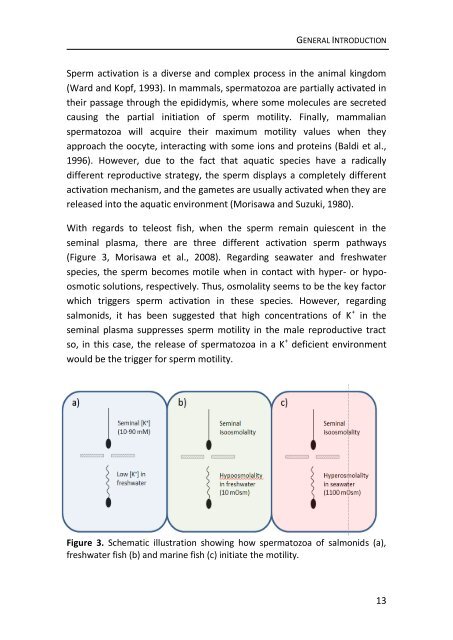chapter 3 - RiuNet
chapter 3 - RiuNet
chapter 3 - RiuNet
Create successful ePaper yourself
Turn your PDF publications into a flip-book with our unique Google optimized e-Paper software.
GENERAL INTRODUCTION<br />
Sperm activation is a diverse and complex process in the animal kingdom<br />
(Ward and Kopf, 1993). In mammals, spermatozoa are partially activated in<br />
their passage through the epididymis, where some molecules are secreted<br />
causing the partial initiation of sperm motility. Finally, mammalian<br />
spermatozoa will acquire their maximum motility values when they<br />
approach the oocyte, interacting with some ions and proteins (Baldi et al.,<br />
1996). However, due to the fact that aquatic species have a radically<br />
different reproductive strategy, the sperm displays a completely different<br />
activation mechanism, and the gametes are usually activated when they are<br />
released into the aquatic environment (Morisawa and Suzuki, 1980).<br />
With regards to teleost fish, when the sperm remain quiescent in the<br />
seminal plasma, there are three different activation sperm pathways<br />
(Figure 3, Morisawa et al., 2008). Regarding seawater and freshwater<br />
species, the sperm becomes motile when in contact with hyper- or hypoosmotic<br />
solutions, respectively. Thus, osmolality seems to be the key factor<br />
which triggers sperm activation in these species. However, regarding<br />
salmonids, it has been suggested that high concentrations of K + in the<br />
seminal plasma suppresses sperm motility in the male reproductive tract<br />
so, in this case, the release of spermatozoa in a K + deficient environment<br />
would be the trigger for sperm motility.<br />
Figure 3. Schematic illustration showing how spermatozoa of salmonids (a),<br />
freshwater fish (b) and marine fish (c) initiate the motility.<br />
13
















